
- Pages: vi + 232 p.
- Size:156 x 234 mm
- Illustrations:1 b/w, 1 tables b/w.
- Language(s):English, French
- Publication Year:2011
- € 80,00 EXCL. VAT RETAIL PRICE
- ISBN: 978-2-503-53158-8
- Hardback
- Temporarily Out of Stock
- € 80,00 EXCL. VAT RETAIL PRICE
- ISBN: 978-2-503-53976-8
- E-book
- Available
"This collection (...) represents a respectable and interesting contribution to an ongoing debate." (Charles West, in The Mediaeval Journal, Vol. 2.2 (2012), p. 103-105)
"Mainly focused on different geographical regions of medieval Europe, [these essays] contain a variety of reflections on feudalism, which cast light on the current status of the feudal constructs, provide ammunition for their overthrow, and suggest promising approaches to future investigation of medieval social and political history." (Elizabeth A. R. Brown, in: The Medieval Review, 12.06.10)
This up-to-date discussion takes as its starting point the challenge to the traditional notion of feudalism in the twenty-five years since the publication of Jean-Pierre Poly and Eric Bournazel’s work on the ‘mutation féodale’ and Susan Reynolds’s attack on the very idea of a feudal society in the Middle Ages. While these challenges have presented a new picture of Western Europe in the so-called feudal age, one more focused than the traditional model of feudalism was, no new scholarly consensus has yet emerged.
The volume has two objectives. Firstly, it discusses the present state of research, bringing together leading representatives of the various interpretations of feudalism. It examines the character of medieval society, including questions of landholding, government, and the relationship between king and aristocracy. Secondly, it provides a new geographic perspective on the subject by considering countries little discussed from a feudal perspective. In addition to discussing countries that have been prominent in previous studies of feudalism such as England and France, the book also includes contributions on Germany, Spain, Scandinavia, Hungary, and Romania, thus supplying a truly European perspective and a comparative view of social structure in different regions of Europe.
Introduction
SUSAN REYNOLDS: ‘Fiefs and Vassals after Twelve Years’
BRIGITTE KASTEN: ‘Economic and Political Aspects of Leases in the Kingdom of the Franks during the Eighth and Ninth Centuries: A Contribution to the Current Debate about Feudalism’
DOMINIQUE BARTHÉLEMY: ‘Vassaux et fiefs dans la France de l’an mil’
HÉLÈNE DÉBAX: ‘L’Aristocratie languedocienne et la société féodale: Le témoignage des sources (Midi de la France: XIe et XIIe siècles)’
GERD ALTHOFF: ‘Establishing Bonds: Fiefs, Homage, and Other Means to Create Trust’
JOHN HUDSON: ‘Imposing Feudalism on Anglo-Saxon England: Norman and Angevin Presentation of Pre-Conquest Lordship and Landholding’
ADAM J. KOSTO: ‘What about Spain? Iberia in the Historiography of Medieval European Feudalism’
MICHAEL H. GELTING: ‘The Problem of Danish ‘Feudalism’: Military, Legal, and Social Change in the Twelfth and Thirteenth Centuries’
ERIK OPSAHL: ‘‘[…] nonetheless [he] fulfilled his obligations towards the hirð’: Fealty and Politics in Medieval Norway’
JÁNOS M. BAK: ‘Feudalism in Hungary?’
COSMIN POPA-GORJANU: ‘The Question of Feudalism in the Romanian Principalities in the Middle Ages’




